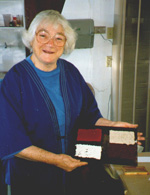India Who?
By Ilsa Perse
India Flint who? Shakerag what? This was my reaction 14 months ago when a friend told me about a woman she had met at a Dorothy Caldwell workshop. "You should see what happens when she wraps leaves in fabric that she cooks up in her room at night." Intrigued, I went to the website, http://www.indiaflint.com/ and immediately ordered India's gorgeous, informative book, Eco Colour, Murdoch Books of Australia, 2008.
I read the book from cover to cover, and tried my hand at the fool-proof onion skin wrap. I was hooked. I told my friend Judilee Fitzhugh (Turkey Red Journal Spring 2010) about my fabulous discovery, only to be told that she already knew about India Flint. When I said, India would be teaching at Shakerag in June, Judilee said, "Let's go." And we did.
| Red onion skin print on silk charmeuse | India Flint opening up a bundle at Shakerag |
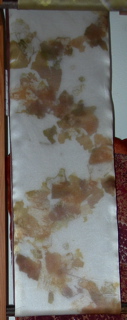 |
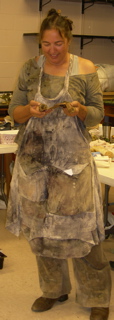 |
| Photograph Copyrightby Ilsa Perse | Photograph Copyright by Ilsa Perse |
What is Shakerag?
The name comes from a local practice dating back to Prohibition and whiskey distribution in the "hollers" of Tennessee. The Shakerag Summer Workshops occur for two weeks in June, attracting teachers and students from all over the world in the fields of ceramics, book arts, fiber, electronic media, and more. The food is fabulous; the setting is gorgeous; and the organizers are generous and brilliantly organized! The studios are open 24 hours a day. Summer camp on steroids.
In the Eight-and-a-half month wait between registering for India's class and actually getting to take it, I continued to study Eco Colour. I wrapped walnut leaves, maple leaves, dogwood leaves—with disappointing results. I perfected onion skin bundles. Spring arrived, and I wrapped daffodils and interesting yellow blotches resulted. Bearded iris bloomed and I bundled them with great success. Later in the summer I bundled dahlia petals.
| Dahlia print on silk charmeuse | Purple bearded iris flower print on silk charmeuse |
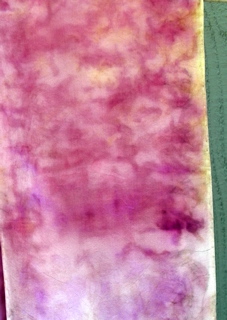 |
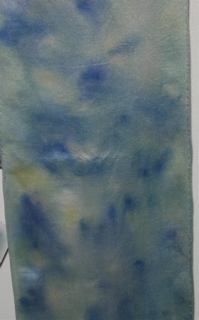 |
| Photograph Copyright by Ilsa Perse | Photograph Copyright by Ilsa Perse |
In her book, India advises patience and encourages experimentation. Experimentation is easy. Patience was another matter. The colorful stain left by blood orange on a napkin encouraged me to clamp fabric and blood orange slices between pieces of wood. I put this clamped "creature" in a plastic bag and forgot about it. Absent-mindedness is a great way to cultivate patience. When things got a little smelly and started looking a bit moldy, I looked inside, expecting citrus slice prints that were red. Instead the detailed prints were blue, really blue. The fun and magic had just begun. I began to wonder how we were going to make a five day workshop accomplish what I had achieved in three weeks of waiting in my home studio.
| Blood orange slice print | ||
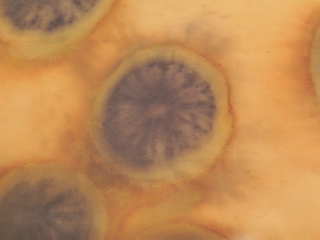 |
||
| Photograph Copyright by Ilsa Perse |
A Walk in the Woods
The class was called "A Walk in the Woods." Shakerag Workshops take place at St. Andrews Sewanee School in the rolling hills of Tennessee. There were trees everywhere. We would be collecting leaves and other flora, but only from the forest floor. Nothing was to be picked off the trees. Everyone in the class had their eyes on the beautiful little Forest Pansy Redbud Tree (Cercis candensis) with its maroon leaves growing on the grounds. It would be off limits, until...
t the first meeting on Sunday evening, we learned the secrets for making eco prints quickly: boiling water, for a long period of time. Dried up leaves wrapped in fabric around a stick, tied up tightly with some odd pieces of string, and then dropped in boiling water. How was this going to work?
We reassembled Monday morning to begin a magical journey. Not only is India part botanist, chemist, raconteur, and great artist, she guides her students on a spiritual as well as an artistic journey. It is obvious that she lives her art and her belief in treading lightly on the earth. She wears clothes made from eco-colored fabric, much of which is repurposed and refashioned from something else. The Mother of Invention in so many ways.
The first walk in the woods was a quiet one, as we focused on what was happening around us and beneath our feet. We brought back our collection of dried things and began busily bundling them all. We laid out our first set of bundles. They seemed totemic. We dropped them in the boiling water where they would continue to boil for an hour and a half, and then cool in the vat overnight. We would have to wait until morning to see the results.
On Tuesday morning we laid out our bundles on the floor, and then eagerly tore them open. Shortly afterward, India walked into the classroom. "You cheeky Americans," she said with a mixture of humor and annoyance. Knowing what I know now about the magic of eco-printing, I understand India's dismay at our rush. She had wanted to be there with us, to celebrate what we were doing. At that point I realized that it was time to slow down and be more mindful.
| Queen Anne's Lace | Peach tree |
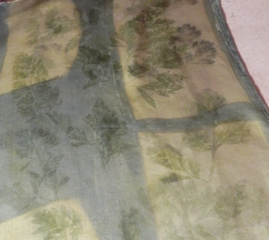 |
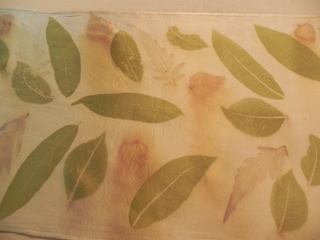 |
| Photograph Copyright by Ilsa Perse | Photograph Copyright by Ilsa Perse |
Although we were only supposed to use leaves that were indigenous to the area, we cheated a little when we wrapped dried eucalyptus leaves brought from Florida by Celeste, in our bundles. India has an abundance of all varieties of eucalypts in Australia and her work with them is gloriously documented in her book. Their grayish foliage makes an astonishing red/orange print, which we achieved with the leaves brought by Celeste. For those of us who do not have a eucalyptus grove in our neighborhoods, dried florist eucalyptus leaves work, too.
The showy eucalyptus prints were good for beginners who need exciting, immediate results! However, what resulted from the dried leaves of the tulip poplar (Liriodendron tulipifera), the indigenous oak leaves, locust trees, dogwoods, and more were equally lovely, though not quite so flashy. One grows to appreciate subtlety with eco-prints.
| Eucalyptus leaf prints | ||
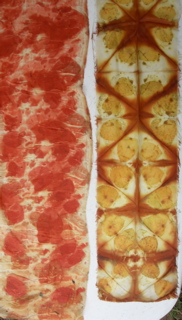 |
||
| Photograph Copyright by Ilsa Perse |
Unlike natural dyeing where the fabric is mordanted, India's method works better when fabric is not mordanted. I discovered this because I had brought only mordanted fiber with me and my prints were less vibrant than those made by others with the same leaves.
Because so many different collections of bundles were boiled together, the different leaf dyes intermingled and created all manner of interesting results. The introduction of metals into the pot or wrapped with the leaves made new and exciting things happen, as well.
We continued exploring, bundling, boiling, and unwrapping for five exciting days. And even though our cauldrons were outside, the smell of cooking leaves, heavily influenced by eucalyptus, made our room smell quite exotic. Everyone at Shakerag realized that India's class was having way too much fun in a room that smelled really good.
There was more to the workshop than printing on fabric. We made eco prints on paper; learned how to make a very complicated book; and discovered all the useful things one can do with old tea bags.
The five days of the workshop were filled with endless discoveries and lots of laughing. On the last day of the workshop, after the studios were cleaned up, each workshop displayed the results of their five days labor. One was struck by the seriousness of purpose of all the different participants. But it was in India's class that seriousness of purpose met productivity. Every surface of our studio was covered with fabulous pieces of fabric. Everyone was astonished by what was produced in the room with the strong smell.
Immediately upon arriving home, Judilee and I began bundling leaves from local trees. We both live in the country and have lots and lots of trees. I collect leaves both from the trees and from the ground beneath them. My friends now know to alert me if they have pruned their purple leaved plum trees.
India wraps (bundles) fabric and leaves around twigs and sticks. The tannin in the wood works its magic on the leaves that are being bundled. However, I now want to see the leaf print unaffected by tannin, so I am wrapping leaves and fabric around PVC pipe. Not terribly organic, but it is allowing me to see the leaf print and nothing but the leaf print.
Eco printing has taught me patience. I can now wait three weeks between bundling/ boiling and unwrapping. The results are worth the wait. Judilee and I often wait until we are together to open up our treasures. In the past three months, we have made dozens and dozens of bundles. The resulting fabric continues to astonish and amaze us.
In addition to the main layer of fabric, I often roll organza or other sheer fabric on top of the leaves as I wrap the bundle. This results in two pieces of printed fabric, a sheer piece that replicates the heavier piece.
As with other natural dyes, better results are achieved with protein fibers, such as silk and wool, which have been soaked in a soy milk solution prior when bundling flowers. I apply no heat with flower bundles. Flowers, unlike leaves, compost pretty quickly, so the wait is not very long for really nice results.
I often over-dye the eco printed fabric in a dye bath made from the plant that made the print. I have been using various shibori techniques as well, for example, Queen Anne's lace printed fabric, over-dyed in a QAL dye bath, and then folded, clamped, and dipped in indigo.
| Chartreuse leaf prints | Print from pond smartweed |
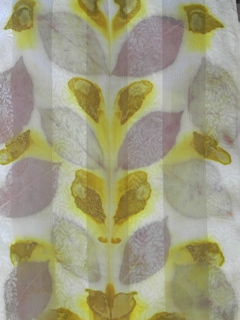 |
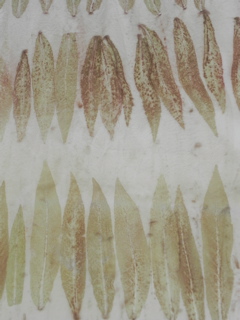 |
| Photograph Copyright by Ilsa Perse | Photograph Copyright by Ilsa Perse |
The Walk in the Woods workshop opened up a world of coloring and surface design that has endless possibilities. Making bundles of fabric and leaves is completely addictive. I hope when winter sets in, I can withdraw from making leaf bundles for a while.
In addition to her informative, well organized website, and her beautiful and exhaustive book Eco-Colour, India maintains a terrific blog: http://prophet-of-bloom.blogspot.com/. On the first page of the blog, where there is so much to look at, there is an alphabetical listing of the two or three hundred things that India keeps track of. United States is one of her many topics. Click on it, and you will get to a page that has the Shakerag Walk in the Woods entries. Here you can see her version of what happened in Tennessee. Down the rabbit hole in the blog, the world changes. You will get a glimpse of India's World ("whirled" as she would say) and you will want to go there yourself.
 Turkey Red Journal
Turkey Red Journal
